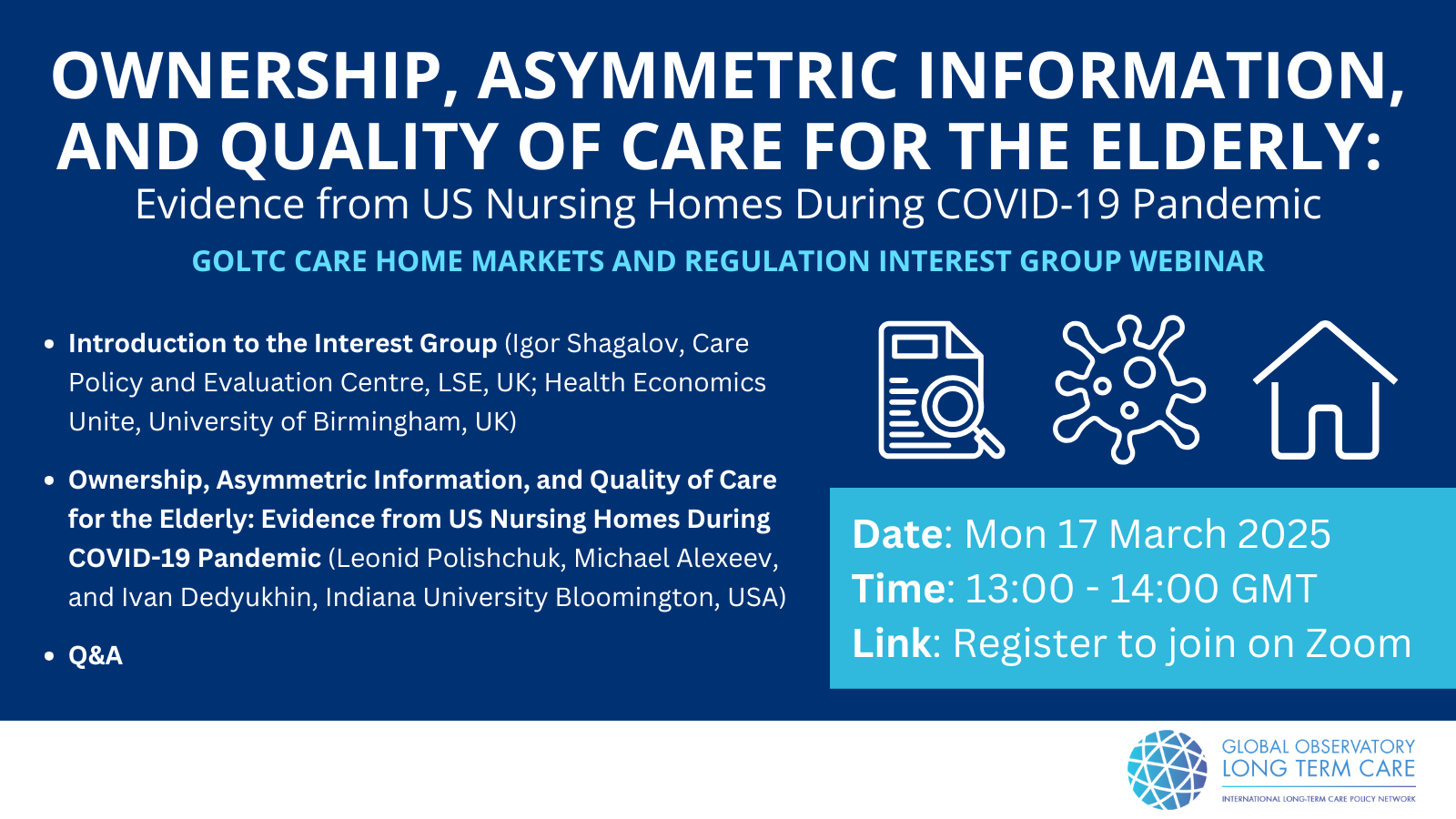Care Home Markets and Regulation Interest Group webinar: Ownership, Asymmetric Information, and Quality of Care for the Elderly: Evidence from US Nursing Homes During COVID-19 Pandemic. 17 March 2025
Care Home Markets and Regulation Interest Group webinar: Ownership, Asymmetric Information, and Quality of Care for the Elderly: Evidence from US Nursing Homes During COVID-19 Pandemic. 17 March 2025
17 Mar, 2025
Events
Published:
14 Jan 2025

Ownership, Asymmetric Information, and Quality of Care for the Elderly: Evidence from US Nursing Homes During COVID-19 Pandemic
GOLTC Care Home Markets and Regulation Interest Group webinar
Date: 17 March 2025
The pandemic has shown that in many countries there is much to do to improve the quality of life and safety of people living in residential care facilities, and a tool available to government are regulatory and market shaping policies. This is the third of a series of webinars to explore COVID-19 Lessons to improve care home standards and regulatory approaches, featuring Leonid Polishchuk, Michael Alexeev and Ivan Dedyukhin from Indiana University.
Abstract of presentation: A common cause of market failures is asymmetric information, and hence the reliance on market incentives and signals could be questioned when quality of goods and services is not properly observable and verifiable. This is a well-known reason for caution in the outsourcing of social services to for-profit providers. In such an environment, nonprofit providers can offer additional quality assurance. However, when quality becomes better observable and verifiable, and hence could earn a market premium, market incentives are closer aligned with social welfare, and the quality gap expected between nonprofit and for-profit provision is likely to narrow. We explore this conjecture, using the case of US nursing homes during the COVID-19 pandemic.
The pandemic supplied new tangible and publicly observable nursing home performance measures, i.e., infection and death rates among residents. Such measures could serve as care quality indexes, revealing aspects and attributes of the nursing home care that remained hidden before the pandemic. Econometric analysis demonstrates a significant gap between for-profit and nonprofit nursing homes in COVID-19 infection rates early on in the pandemic, when the industry was caught by surprise (“Gotcha effect”). However, in the ensuing catching-up process triggered by increased transparency, this gap steadily declined, eventually leading to statistical parity between two types of ownership and to lower mortality rates in for-profit institutions. We explore the role of local market structure in the adjustment of nursing home industry to the pandemic; retroactively evaluate the reliability of the official ranking system in predicting nursing homes’ performance; and look for evidence of sustainable learning-by-doing effect of the pandemic.
The webinar will cover:
1. Introduction to the Global Observatory of Long-Term care and welcome (Adelina Comas-Herrera, Care Policy and Evaluation Centre, LSE, UK).
2. Introduction to the Care Home Markets and Regulation Interest Group (Igor Shagalov, Care Policy and Evaluation Centre, LSE, UK; Health Economics Unite, University of Birmingham, UK).
3. Presentation: Ownership, Asymmetric Information, and Quality of Care for the Elderly: Evidence from US Nursing Homes During COVID-19 Pandemic (Leonid Polishchuk, Michael Alexeev, and Ivan Dedyukhin, Indiana University Bloomington, USA).
4. Questions & Answers session (Jose-Luis Fernandez, Care Policy and Evaluation Centre, LSE, UK)

